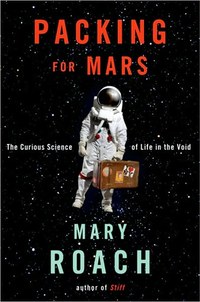Review: Packing for Marsby Jeff Foust
|
| Roach takes, if not a lighthearted approach to the subject, certainly a witty, if not downright snarky, view on life in space. |
Roach is a newcomer to space, but the author of previous books on cadavers (Stiff), the afterlife (Spook), and sex (Bonk), said during a panel at the SETICon conference in Santa Clara, California, over the weekend that writing about spaceflight wasn’t a big departure for her. “I’m always writing about the human body in unusual circumstances,” she said. And space does provide plenty of unusual circumstances, including the tricky issue of relieving oneself in weightlessness.
Packing for Mars, though, is about far more going to the bathroom in space. She covers the psychological issues of long-duration spaceflight, the various issues of living and working in weightlessness, hygiene in space (with the experience of Gemini 7, when Frank Borman and Jim Lovell spent two weeks together in a cramped capsule, as an extreme case), eating in space, and, yes, sex in space. (Although that chapter is more about the lack of sex in space; she thoroughly debunks several of the more well-known claims of zero-g sex, including one adult film that claimed to have scenes filmed in a aircraft flying parabolic arcs to provide brief moments of zero-g.) Roach may be new to space but she’s done her homework: her book takes her to NASA centers, Star City in Russia, Japan, and Devon Island in the Canadian Arctic; she also gets to fly on a NASA zero-g aircraft flight.
At SETICon, Roach said she got interested in the subject after finding out someone she knew was working at an extended bedrest facility, where people lay in bed for months at a time to simulate some of the conditions of weightlessness; this, in turn, inspired her to look at other efforts to study the human condition in space. “I thought it would be another interesting subculture that a lot of people aren’t familiar with,” she said. “It’s kind of surreal and quirky in the way I like my material to me.”
| “There’s a sense of awe that we even undertake such a preposterous thing and I would be sad were it all to stop,” she said of human space exploration. |
That last statement describes the essence of Packing for Mars. Roach takes, if not a lighthearted approach to the subject, certainly a witty, if not downright snarky, view on life in space, not just in the main text but in frequent footnotes. Take, for example, her description of the feeling of weightlessness after her trip on the NASA aircraft: “Weightlessness is like heroin, or how I imagine heroin must be. You try it once, and when it’s all over, all you can think about is how much you want to do it again.” Those who feel that space is serious business will likely be turned off by this: how dare you make fun of our heroic astronauts and scientists? On the other hand, this approach is what makes the book so interesting (and, yes, funny at times) to read. After all, so much of humor is scatological in origin, so topics like “fecal decapitation” set themselves up for Roach like a hanging curveball for Alex Rodriguez. (Not all the book, for certain, is fun and giggles: she writes about having a conversation on Devon Island about the Columbia accident with Jon Clark, only to realize partway through the conversation that he was married to one of the astronauts on that mission.)
At the end of Packing for Mars, Roach briefly discusses the prospects for a human mission to Mars. Given all of the challenges of keeping humans alive and in good physical and mental health she elucidates in the book, you might think she would be skeptical about such exploration. In fact, she endorses the mission, but not for reasons of science, or expanding human presence beyond Earth, or any other rationales usually put forward for such exploration. “I see a back-handed nobility in excessive, impractical outlays of cash prompted by nothing loftier than a species joining hands and saying, ‘I bet we can do this,’” she writes in the book’s final paragraph. “Let’s squander some on Mars. Let’s go out and play.”
That’s a surprisingly flip answer given the cost and risk involved (including radiation, a risk to human spaceflight that gets only a limited discussion in the book) and one that probably won’t fly in Washington, given the struggles today to fund less ambitious near-term human exploration efforts. “I hadn’t really given that much thought to it” before starting the book, she said at SETICon. “There’s a sense of awe that we even undertake such a preposterous thing and I would be sad were it all to stop.” The challenge, then, is to find a way to harness that sense of awe to sustain the long-term support needed for human exploration to Mars and elsewhere beyond Earth orbit, in spite of the physiological and psychological obstacles so cleverly described in her book.
